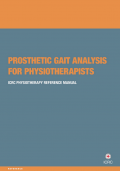Introduction
This week we are going to delve into all aspects of post-fitting rehabilitation. This includes exercises programmes, first-fitting and gait training such as weight bearing and balance, co-ordination and endurance, functional activities and advanced gait training skills.
Objectives for this week
At the end of this week you should be able to:
- Have a good knowledge about how to don and doff a TT and TF prosthesis and how to teach it to your patients.
- Have a good understanding on how to manage prosthetic socks during the post-fitting rehabilitation process and how to teach the patient when to add or remove socks.
- Understand the importance of post-fitting rehabilitation and have a good idea about exercises to improve range of motion, strength, balance, coordination, agility and endurance in order to improve patient’s physical and functional status and maximise prosthetic use.
- Have a good knowledge of gait training exercises, understand their purpose and the importance of a good progression.
Topic 1: Post-fitting rehabilitation
The aim of this topic is to provide an overview of post-fitting rehabilitation, what type of exercises to use to improve a patient’s functional outcomes and enhance all physical demands required for prosthetic use.
- Much of the post fitting rehabilitation continues with similar exercises to those that we learned about in Topic 2: Socks, Liners, Donning and Doffing
Donning a prosthesis refers to the application of a prosthetic device, doffing refers to the act of removing a prosthetic device. The aim of this topic is to gain knowledge of socks and liners and the process of donning and doffing a prosthesis.
- Prosthetic socks are simple, relatively inexpensive and critically important. Learn why by Topic 3: Prosthetic rehabilitation
The aim of this topic is to enable you to have a good knowledge about prosthetic rehabilitation including gait training and what type of exercises to propose to your patient to allow him to walk in the most efficient manner possible, to reduce energy expenditure and to correct gait deviations.
To start watch this short interview with Dr Robert Gailey where he gives some tips for this phase of rehabilitation (optional).
- Read an overview of Quiz
You are not assessed on this quiz, it is designed for you to test your knowledge on the topics this week.
Case Study
Watch this video:
Discussion
Go to the Optional: Explore other resources
The following resources are optional for you to read/view but will further expand your knowledge on this week’s topics:
Prosthetic Gait Analysis for Physiotherapists
This is the course textbook from ICRC which will be available to all participants of the course.
× Como posso te ajudar?×Ola!
Como podemos ajudar?
- Read an overview of Quiz
- Prosthetic socks are simple, relatively inexpensive and critically important. Learn why by Topic 3: Prosthetic rehabilitation


